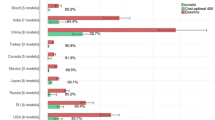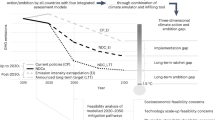Abstract
This paper synthesizes results of the multi-model Energy Modeling Forum 27 (EMF27) with a focus on climate policy scenarios. The study included two harmonized long-term climate targets of 450 ppm CO2-e (enforced in 2100) and 550 pm CO2-e (not-to-exceed) as well as two more fragmented policies based on national and regional emissions targets. Stabilizing atmospheric GHG concentrations at 450 and 550 ppm CO2-e requires a dramatic reduction of carbon emissions compared to baseline levels. Mitigation pathways for the 450 CO2-e target are largely overlapping with the 550 CO2-e pathways in the first half of the century, and the lower level is achieved through rapid reductions in atmospheric concentrations in the second half of the century aided by negative anthropogenic carbon flows. A fragmented scenario designed to extrapolate current levels of ambition into the future falls short of the emissions reductions required under the harmonized targets. In a more aggressive scenario intended to capture a break from observed levels of stringency, emissions are still somewhat higher in the second half due to unabated emissions from non-participating countries, emphasizing that a phase-out of global emissions in the long term can only be reached with full global participation. A key finding is that a large range of energy-related CO2 emissions can be compatible with a given long-term target, depending on assumptions about carbon cycle response, non-CO2 and land use CO2 emissions abatement, partly explaining the spread in mitigation costs.





Similar content being viewed by others
Notes
A target for temperature instead may prove to be a more policy-relevant formulation, but it will require further methodological work on uncertainty and the representation of climate dynamics in integrated assessment models.
Following the approach in van Vuuren et al. (2011b), we exclude three agents whose forcing is more speculative and often treated exogenously in the models: nitrate aerosols, mineral dust aerosols, and land use albedo changes (Abbreviated 3A). The median estimate for 3A forcing in IPCC (2007) is −0.3 W/m2. We refer to the total controlled anthropogenic forcing in this study as AN(ot)3A forcing. See Rose et al. (this issue) for more details.
This formulation is based on the suggestion in Frankel (2007), in which negotiated reductions relative to a base year were translated into reductions from an expected baseline.
In both cases a discount rate of 5 % was used ex post, though it should be noted that individual models may use different rates and treat time preferences differently.
Note that in all cases the price rises significantly over time, so that high future levels are suppressed by reporting only the time-average price.
Models generally assume that the land use and non-CO2 sources are characterized by a limited amount of low cost mitigation options followed by steeply rising marginal costs of further emissions reductions (Figure S6). Once these options are exhausted, additional reductions must occur in the energy sector, whose marginal abatement cost curve is less convex. Further research on non-energy abatement options could change this characterization.
See Krey et al. (this issue) for further discussion on the impact of technology availability on costs.
One consequence of the bottom-up formulation is that model differences in relative growth rates across regions are emphasized in these scenarios, revealing an important dimension of variation and uncertainty that tends not to emerge as clearly with a harmonized target.
Only a few models represent energy-intensive industries and trade in non-energy goods with sufficient disaggregation to directly assess the potential extent of “off-shoring”.
References
Arora VK et al (2013) Carbon–concentration and carbon–climate feedbacks in CMIP5 earth system models. J Clim 26:5289–5314
Bibas R, Méjean A (2013) Potential and limitations of bioenergy for low carbon transitions. Climatic Change. doi:10.1007/s10584-013-0962-6
Blanford GJ, Rose SK, Tavoni M (2012) Baseline projections of energy emissions in Asia. Enegry Econ 34:S284–S292
Blanford GJ et al (this issue) Trade-offs between mitigation costs and temperature change. Clim Chang, this issue. doi:10.1007/s10584-013-0869-2
Clarke LE et al (2009) International climate policy architectures: overview of the EMF22 international scenarios. Energy Econ 31:S64–S81
Frankel J (2007) Formulas for Quantitative Emissions Targets. In: Aldy JE, Stavins RN (eds), Architectures for Agreement. Cambridge University Press, pp 31–56
Hof AF et al (2012) The benefits of climate change mitigation in integrated assessment models: the role of the carbon cycle and climate component. Clim Chang 113:897–917
IPCC (2007) Climate Change 2007: The Physical Science Basis. In: Solomon S et al (eds), Contribution of Working Group I to the Fourth Assessment Report of the Intergovernmental Panel on Climate Change. Cambridge University Press
Jakob M et al (2012) Time to act now? Assessing the costs of delaying climate measures and benefits of early action. Clim Chang 114:79–99
Krey V et al (this issue) Getting from here to there – energy technology pathways in the EMF27 scenarios. Clim Chang, this issue. doi:10.1007/s10584-013-0947-5
Kriegler E et al (2013) Can we still meet 2 °C with global climate action? The LIMITS study on implications of Durban Action Platform scenarios. Clim Chang Econ, in revision
Kriegler E et al (this issue) The role of technology for climate stabilization: overview of EMF27 study on energy system transition pathways under alternative climate policy regimes. Clim Chang, this issue. doi:10.1007/s10584-013-0953-7
Leimbach M et al (2009) Mitigation costs in a globalized world: climate policy analysis with REMIND-R. Environ Model Assess 15(3):155–173
Luderer G et al (2013) Implications of weak near-term climate policies on long-term mitigation pathways. Clim Chang. doi:10.1007/s10584-013-0899-9
Massetti E, Tavoni M (2011) The cost of climate change mitigation policy in Eastern Europe and Former Soviet Union. Clim Chang Econ 2(4):341–370
Riahi K et al (2013) Locked into Copenhagen Pledges—Implications of short-term emission targets for the cost and feasibility of long-term goals. Technol Forecast Soc Chang, in revision
Rogelj J et al (2011) Emissions pathways consistent with a 2 °C global temperature limit. Nat Clim Chang 1:413–441
Rogelj J et al (2012) 2020 emissions levels required to limit warming to below 2 °C. Nat Clim Chang. doi:10.1038/nclimate1758
Rose SK et al (this issue) The role of non-Kyoto gas forcing in GHG stabilization. Clim Chang, this issue. doi:10.1007/s10584-013-0955-5
Sinn H-W (2012) The Green Paradox: A Supply-Side Approach to Global Warming. MIT Press
Tavoni M, Tol RSJ (2010) Counting only the hits? The risk of underestimating the costs of stringent climate policy. Clim Chang 100:769–778
Tavoni M et al (2013) The distribution of the major economies’ effort in the Durban platform scenarions. Clim Chang Econ (accepted)
Tol RSJ (2008) The social cost of carbon: trends, outliers and catastrophes. Econ Open Access Open Assess E Jl 2:2008–25
UNFCCC (2010) Report of the COP16, Cancun, December 2010, Addendum: Decision 1/CP16, found at: http://unfccc.int/resource/docs/2010/cop16/eng/07a01.pdf
van Vliet et al (2012) Copenhagen accord pledges imply higher costs for staying below 2°C warming. Clim Chang 113:551–561
van Vuuren et al (2011a) How well do integrated assessment models simulate climate change? Clim Chang 104(2):255–285
van Vuuren et al (2011b) The representative concentration pathways: an overview. Clim Chang 109(1–2):5–31
Weyant JP, de la Chesnaye FC, Blanford GJ (2006) Overview of EMF 21: Multigas Mitigation and Climate Policy. Energy J, Multi-Greenhouse Gas Mitiation and Climate Policy Special Issue, pp 1–32
Acknowledgments
The authors are grateful to three anonymous reviewers for their insightful comments. The contributions of Elmar Kriegler and Massimo Tavoni to this research was supported by funding from the European Union’s Seventh Framework Programme FP7/2011 under grant agreement no. 282846 (LIMITS).
Author information
Authors and Affiliations
Corresponding author
Additional information
This article is part of the Special Issue on “The EMF27 Study on Global Technology and Climate Policy Strategies” edited by John Weyant, Elmar Kriegler, Geoffrey Blanford, Volker Krey, Jae Edmonds, Keywan Riahi, Richard Richels, and Massimo Tavoni.
Electronic supplementary material
Below is the link to the electronic supplementary material.
ESM 1
(DOCX 274 kb)
Rights and permissions
About this article
Cite this article
Blanford, G.J., Kriegler, E. & Tavoni, M. Harmonization vs. fragmentation: overview of climate policy scenarios in EMF27. Climatic Change 123, 383–396 (2014). https://doi.org/10.1007/s10584-013-0951-9
Received:
Accepted:
Published:
Issue Date:
DOI: https://doi.org/10.1007/s10584-013-0951-9




